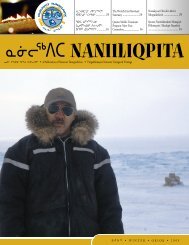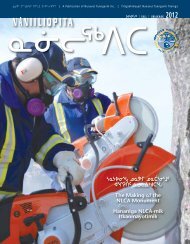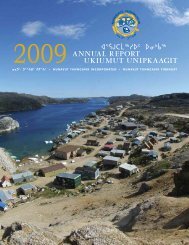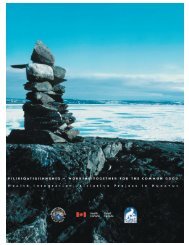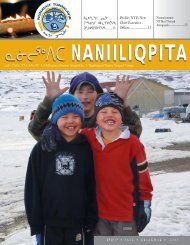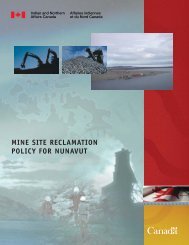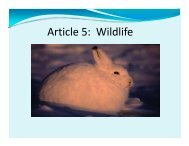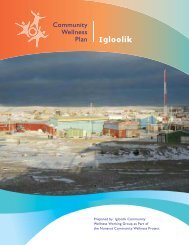Ensuring a Sustainable and Humane Seal Harvest - Nunavut ...
Ensuring a Sustainable and Humane Seal Harvest - Nunavut ...
Ensuring a Sustainable and Humane Seal Harvest - Nunavut ...
You also want an ePaper? Increase the reach of your titles
YUMPU automatically turns print PDFs into web optimized ePapers that Google loves.
ENSURING A SUSTAINABLE ANDHUMANE SEAL HARVESTIntroductionFor over 30 years, Canada’s commercial seal harvest in the Northwest Atlantic hasattracted international attention <strong>and</strong> criticism from animal rights <strong>and</strong> welfare activists. Thecampaign against the commercial seal harvest, led by several internationalnongovernmental organizations (NGOs) <strong>and</strong> celebrities, resulted in a ban by the EuropeanUnion — then the European Communities — on the importation of pelts from very youngharp <strong>and</strong> hooded seals in the early 1980s, <strong>and</strong> the collapse of international sealskinmarkets. Despite far-reaching changes to Canadian harvesting regulations <strong>and</strong> practices inthat period, markets failed to recover <strong>and</strong> the Canadian harvest declined significantly. Thisbegan to change in the mid-1990s as a result of increasing dem<strong>and</strong> in internationalmarkets <strong>and</strong> a rapidly growing harp seal population that reached 5.2 million in 1995. Withresulting increases in Canadian quotas <strong>and</strong> catches came renewed international attentionto the seal harvest <strong>and</strong> a stepped-up NGO campaign to end the commercial harvest, whichhas led to proposed or announced legislative or regulatory actions aimed at banning theimport of seal products in several countries, particularly in Europe. Most worrisome forCanadians involved in the industry has been the possibility of a complete ban on theimportation <strong>and</strong> use of seal products by the 27-member European Union, which wasproposed in September 2006 by the European Parliament.In this context <strong>and</strong> in light of the social, economic <strong>and</strong> cultural importance of the sealharvest for many coastal communities on Canada’s Atlantic coast <strong>and</strong> in the North, theHouse of Commons St<strong>and</strong>ing Committee of Fisheries <strong>and</strong> Oceans (the Committee)decided in late spring 2006 to study, once more, the Canadian seal harvest. TheCommittee focused its attention on four aspects of the seal harvest: its sustainability, itshumaneness, its economic, social <strong>and</strong> cultural importance, <strong>and</strong> its role in achieving <strong>and</strong>maintaining an ecological balance within the marine ecosystem. In the course of this study,the Committee received a technical briefing from officials of Fisheries <strong>and</strong> Oceans Canada(DFO) <strong>and</strong> from the Department of Foreign Affairs <strong>and</strong> International Trade (DFAIT), metwith the new Ambassador for Fisheries Conservation, met with sealers <strong>and</strong> coastalcommunities involved in the harvest, as well as with Members of the European Parliamentvisiting Canada <strong>and</strong> heard from representatives of the key international NGOscampaigning to end the commercial seal harvest <strong>and</strong> from veterinary experts of theIndependent Veterinarian Working Group on the Canadian <strong>Seal</strong> Hunt. The Committee alsowelcomed in Ottawa, representatives of two Inuit organizations, the Inuit Tapiriit Kanatami<strong>and</strong> <strong>Nunavut</strong> Tuungavik Incorporated. The Committee watched a preview of thedocumentary Phoques : le film, <strong>and</strong> heard from its director. Finally, members of theCommittee travelled to the Canadian Coast Guard icebreaker, the Amundsen, to observethe seal harvest <strong>and</strong> DFO’s enforcement activities in the Northern Gulf of St. Lawrence.1




